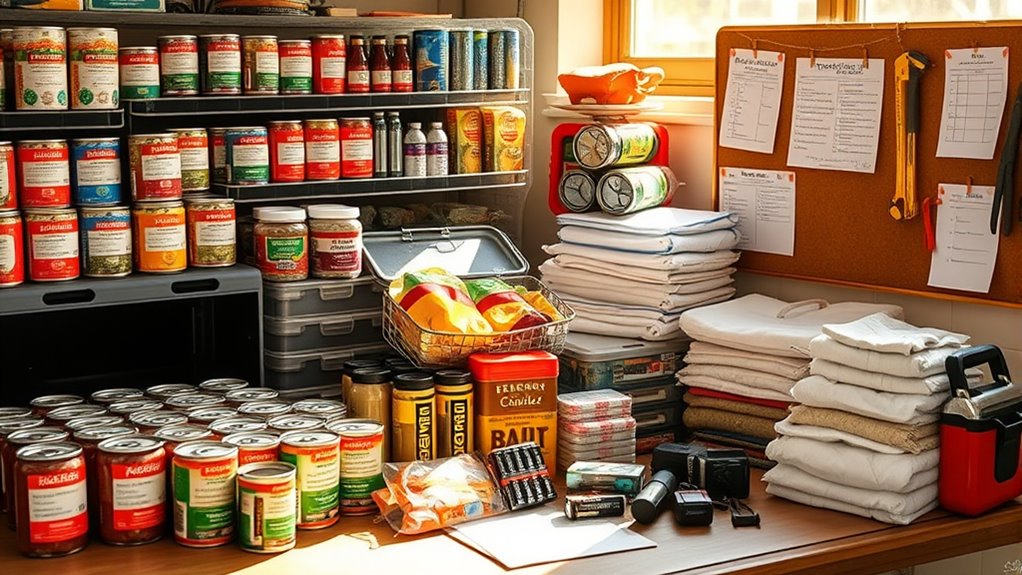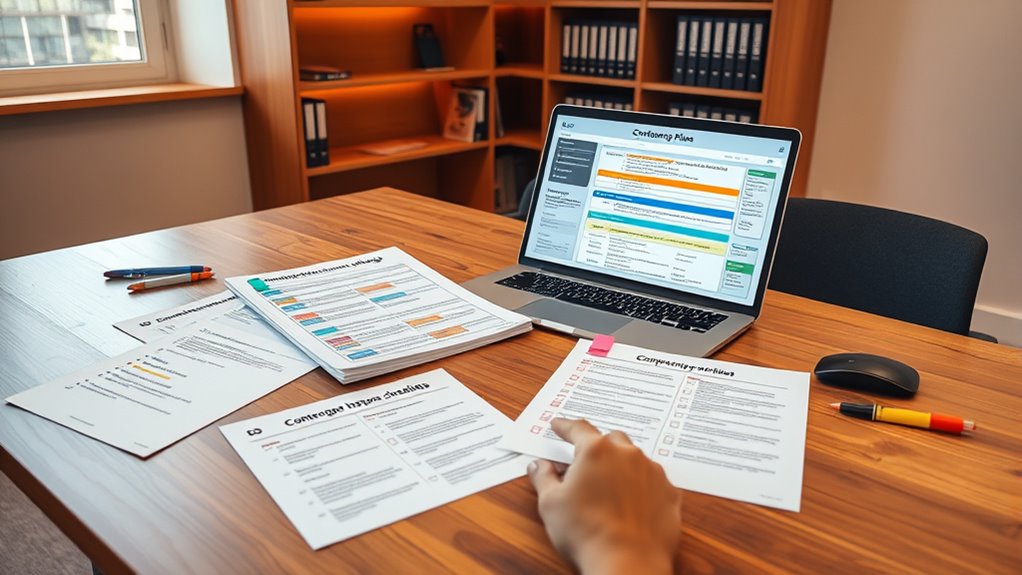To master a 48-hour outage plan in a weekend, start by evaluating risks and setting priorities like backup power and communication. Gather essential supplies, confirm system backups, and develop a clear communication strategy with your team. Create detailed response steps, then test and practice them to identify gaps. Educate your family or team members on procedures, and regularly update your plan based on feedback. For more detailed tips, learn how a structured approach can make your plan more effective.
Key Takeaways
- Conduct a rapid risk assessment to identify critical vulnerabilities and prioritize response actions.
- Prepare emergency supplies, backup power sources, and verify their functionality before the weekend.
- Develop clear communication protocols and assign roles for team coordination during the outage.
- Run simulated outage drills to test response plans, resource deployment, and team readiness.
- Regularly review and update the plan based on feedback and lessons learned from practice sessions.
Assess Your Risks and Set Priorities

Before you can develop an effective 48-hour outage plan, you need to assess your risks and set clear priorities. Start with a thorough risk assessment to identify potential threats, such as power failures, communication breakdowns, or supply shortages. Understanding these risks helps you determine what’s most urgent and what can wait. Priority setting involves ranking these risks based on their likelihood and impact on your operations or safety. Focus on the most critical issues first, like securing backup power or communication channels. By clearly defining your risks and priorities, you create a solid foundation that guides your entire outage plan. This step ensures your efforts are targeted, efficient, and prepared for the challenges ahead.
Gather Essential Supplies and Resources

Once you’ve identified your key risks and priorities, assembling the necessary supplies and resources becomes your next focus. Start by preparing an emergency kit with essentials like water, non-perishable food, medications, and first aid supplies. Next, verify you have a reliable power backup, such as a generator or portable chargers, to keep devices running. Consider adding a flashlight, extra batteries, and a multi-tool for versatility. Also, gather important documents—copies of IDs, insurance policies, and emergency contacts—in a waterproof container. Ultimately, stock up on hygiene items and blankets to stay comfortable. These supplies will help you stay safe and self-sufficient during the outage, ensuring you’re ready for any unexpected challenges.
Create a Communication and Notification Strategy

You need a solid communication and notification strategy to keep everyone informed during the outage. Identify the best channels to reach stakeholders quickly and craft clear messages that prevent confusion. Regular updates guarantee everyone stays aligned and responds effectively as the situation unfolds. Incorporating active listening and empathy into your communication approach can further enhance understanding and trust among team members.
Stakeholder Notification Channels
Have you considered how critical clear communication is during a 48-hour outage? Choosing the right stakeholder notification channels guarantees everyone stays informed and responds appropriately. Start by identifying your emergency contact list, including key personnel and external partners. Next, set a consistent notification frequency—whether hourly updates or upon major developments. Use multiple channels such as email, SMS, phone calls, and messaging apps to reach everyone effectively. Ensure your communication methods are reliable and accessible, especially for urgent updates. Regularly verify contact details and preferred channels. Establishing a communication protocol ensures that all stakeholders understand the procedures and expectations during an outage. This approach minimizes confusion and keeps your team aligned, enabling swift decision-making and coordinated action throughout the outage.
Clear Messaging Frameworks
How can you guarantee your messages during a 48-hour outage are clear, consistent, and actionable? Start by creating a clear messaging framework that guides your communication. Use simple language and avoid technical jargon to ensure everyone understands. Incorporate key elements like updates on emergency kits and power backup status to keep stakeholders informed and prepared. Establish predefined messages for different scenarios, so your team can deliver timely, accurate info without confusion. Consistency is essential—use the same tone and terminology across all channels. Make sure your messages emphasize safety procedures, available resources, and next steps. A well-structured communication strategy reduces panic and misinformation, helping everyone stay focused and coordinated during the outage. Incorporate insights from Bedroom design principles to create a calm and reassuring tone that fosters trust and clarity throughout your communication.
Timely Communication Updates
Are you prepared to deliver timely updates that keep everyone informed and reassured during a 48-hour outage? To do this, create a clear communication and notification strategy. First, establish reliable emergency contacts to ensure swift internal alerts. Second, schedule regular social media updates to keep external stakeholders engaged and informed. Third, use a centralized platform to coordinate messages and prevent misinformation. Fourth, prepare pre-drafted messages for different scenarios, enabling quick dissemination. Consistent updates foster trust and reduce confusion during the outage. Remember, timely communication isn’t just about sharing information—it’s about building confidence that your team is actively managing the situation and keeping everyone safe. Incorporating high-quality projectors into your communication plan can also enhance visual displays and real-time updates. This approach minimizes panic and maintains transparency throughout the outage.
Develop a Contingency and Response Plan

Creating a solid contingency and response plan is essential to effectively manage a 48-hour outage. Start by identifying critical systems and implementing effective backup strategies to ensure data integrity and availability. Clearly outline roles and responsibilities so everyone knows their tasks during the crisis. Emotional resilience is key—prepare yourself and your team mentally to stay calm and focused under pressure. Develop step-by-step procedures for common issues, ensuring quick action and minimal downtime. Include communication protocols to keep stakeholders informed. Regularly review and update your plan based on potential risks and lessons learned. Incorporating reliable backup systems can significantly reduce recovery time and data loss. A well-designed contingency plan minimizes chaos, helps maintain operations, and boosts confidence that you can handle the unexpected efficiently.
Test Your Outage Procedures and Make Adjustments

You need to run through your outage procedures from start to finish to see how well they work. Pay close attention to any areas where things slow down or break down. Make adjustments based on what you discover to guarantee your plan is as effective as possible. Incorporating healthy habits like consistent review and adaptation can help maintain the plan’s robustness over time.
Conduct Full Run-Throughs
To guarantee your outage plan is effective, conducting full run-throughs is essential. This helps identify gaps and ensures everyone knows their roles, especially during a power outage. During your practice, focus on these key steps:
- Simulate a power outage to test your response times and communication flow.
- Verify data backup procedures are complete and accessible, avoiding delays during recovery.
- Walk through each team member’s responsibilities to ensure clarity and coordination.
- Document any issues faced and adjust your plan accordingly to improve efficiency.
- Consider insights from family dynamics to foster teamwork and resilience during emergencies.
Identify Improvement Areas
Testing your outage procedures is crucial for uncovering weaknesses before a real emergency occurs. During these tests, evaluate how well your resource allocation supports each team member’s role, ensuring tools and personnel are optimized. Pay close attention to staff training; identify if team members understand their responsibilities and can execute tasks efficiently. Look for gaps in communication or coordination that could slow down your response. Use feedback from your test runs to pinpoint areas needing improvement. Adjust your procedures accordingly, refining resource deployment and providing targeted training sessions. By continuously identifying and addressing these improvement areas, you’ll strengthen your outage plan, making it more resilient and effective. Incorporating visual and auditory cues can aid learning and ensure consistent understanding across your team. This proactive approach ensures your team is prepared and confident when the next outage strikes.
Educate Your Family or Team Members

Educating your family or team members is essential to guarantee everyone knows their roles and responsibilities during a 48-hour outage. Clear communication ensures family safety and smooth team coordination. To do this effectively:
- Explain the overall outage plan, emphasizing safety procedures and emergency contacts.
- Assign specific roles, such as communication point person or supply manager.
- Demonstrate how to use emergency equipment and supplies correctly.
- Practice quick decision-making and problem-solving scenarios with everyone involved.
- Incorporate training on emergency preparedness to enhance everyone’s confidence in handling unexpected situations.
This preparation helps reduce panic and confusion, ensuring everyone understands their part. When your family or team members are well-informed, they can respond confidently, contributing to a safer, more organized outage experience. Clarity and teamwork are your best tools during unexpected disruptions.
Review, Practice, and Keep Your Plan Updated

Regularly reviewing and practicing your outage plan guarantees everyone stays prepared and confident. Schedule routine drills to test your procedures, focusing on key areas like emergency kits and power backup systems. Update your plan whenever there are changes in your household or community resources, ensuring contact info, supplies, and backup options are current. Use the table below to keep track of your plan’s components:
| Element | Status/Update Needed |
|---|---|
| Emergency kits | Check supplies, replace expired items |
| Power backup | Test generators, verify battery backups |
| Communication plan | Confirm contact info, practice calls |
| Evacuation routes | Review routes, identify new hazards |
| Important docs | Scan, update, and store securely |
Staying proactive keeps your plan effective and ready for any outage. Additionally, familiarizing yourself with reliable backup power options can help you select the best solution for your needs.
Frequently Asked Questions
How Often Should I Review and Update My Outage Plan?
You should review and update your outage plan at least every six months to guarantee effective risk mitigation and clear communication strategies. Regular updates help you identify new vulnerabilities and adapt your plan to changing circumstances. During reviews, test communication protocols and refine procedures. Staying proactive ensures your team is prepared, minimizes downtime, and maintains operational resilience, making your outage plan a reliable, living document that evolves with your organization’s needs.
What Are Common Challenges Faced During Outage Drills?
You’ll face challenges like communication gaps that seem to threaten to derail your entire plan and resource allocation issues that feel like juggling flaming torches. During outage drills, these problems often surface, making coordination difficult and causing delays. To succeed, you must identify and address communication gaps early, make certain proper resource allocation, and practice clear, concise communication. Overcoming these hurdles is vital to mastering your outage plan and ensuring smooth execution.
How Can I Ensure All Team Members Understand Their Roles?
You can guarantee all team members understand their roles by fostering clear team communication and emphasizing role clarity. Hold a pre-drill briefing, clearly outline each person’s responsibilities, and encourage questions to clarify uncertainties. Use visual aids or checklists to reinforce understanding, and during practice, observe and provide feedback. Regularly updating everyone and maintaining open communication channels help prevent confusion, ensuring each team member confidently knows their role during the outage.
What Legal or Insurance Considerations Are Involved?
Think of legal compliance and insurance coverage as your safety net beneath a tightrope walk. You must guarantee your outage plan meets all legal requirements and that your insurance coverage is up-to-date, ready to catch any unforeseen fall. Review local regulations, obtain necessary permits, and verify your policies cover outages. By doing so, you safeguard your team and assets, turning potential legal or insurance pitfalls into stepping stones for success.
How Do I Coordinate With Emergency Services During an Outage?
You should establish clear community communication channels with emergency services early on. Share your outage plan and coordinate resource allocation to guarantee swift response. Keep emergency contacts updated and inform your team about procedures. During the outage, maintain open lines of communication, providing timely updates. This proactive approach helps emergency services respond effectively, minimizes confusion, and ensures everyone stays informed and safe throughout the outage.
Conclusion
By following these steps, you’ll be ready for any 48-hour outage, turning what seems like chaos into a manageable challenge. As you prepare your plan this weekend, remember that a little coincidence—like finding that missing flashlight or reconnecting with a neighbor—can make all the difference. Stay proactive, keep practicing, and you’ll discover that being prepared not only eases stress but also creates unexpected moments of connection and confidence when it matters most.









